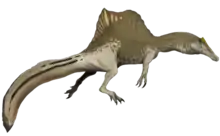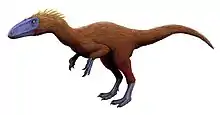Vespersaurus
Vespersaurus is a genus of noasaurine theropod dinosaur from the Late Cretaceous period, found in the Rio Paraná Formation in the Paraná Basin, Brazil. The type and only species is V. paranaensis, which would have lived in the giant prehistoric Botucatu Desert.[1]
| Vespersaurus Temporal range: Early Late Cretaceous | |
|---|---|
 | |
| Holotype foot bones | |
| Scientific classification | |
| Kingdom: | Animalia |
| Phylum: | Chordata |
| Clade: | Dinosauria |
| Clade: | Saurischia |
| Clade: | Theropoda |
| Family: | †Noasauridae |
| Subfamily: | †Noasaurinae |
| Genus: | †Vespersaurus Langer et al., 2019 |
| Type species | |
| Vespersaurus paranaensis Langer et al., 2019 | |
Etymology
The generic name means "evening" or "west lizard" ("vesper" is latin for "evening/west") in reference to the town Cruzeiro do Oeste ("Western Cross") near which the fossils were found. The specific name refers to the Paraná state.[1]
Description

The taxon is notable for its distinct, functionally monodactyl foot anatomy, where the singularly large third digit would have borne most of the weight while walking. Based on the proportions of its holotype remains (MPCO.V 0065d), V. paranaensis was a small theropod, with an estimated body length of 1 to 1.5 meters. This makes it comparable in size to Noasaurus leali and Masiakasaurus knopfleri. Body mass of V. paranaensis was 11.28 kg, nearly that of the ornithischians Jeholosaurus shangyuanensis and Gasparinisaura cincosaltensis.[1]
See also
References
- Langer, Max Cardoso; de Oliveira Martins, Neurides; Manzig, Paulo César; de Souza Ferreira, Gabriel; de Almeida Marsola, Júlio César; Fortes, Edison; Lima, Rosana; Sant’ana, Lucas Cesar Frediani; da Silva Vidal, Luciano; da Silva Lorençato, Rosangela Honório; Ezcurra, Martín Daniel Ezcurra (2019). "A new desert-dwelling dinosaur (Theropoda, Noasaurinae) from the Cretaceous of south Brazil". Scientific Reports. 9 (1): 9379. doi:10.1038/s41598-019-45306-9. PMC 6594977. PMID 31243312.













